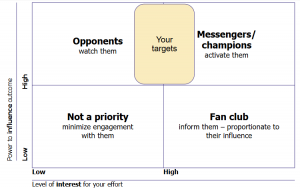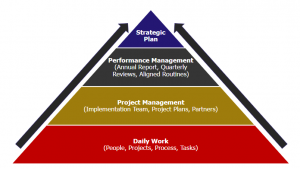This week, President-Elect Donald Trump announced that he will nominate former Small Business Administration leader Linda McMahon to lead the U.S. Department of Education (ED) as part of the incoming Trump-Vance administration. Meanwhile, lawmakers in Congress have continued to make important decisions regarding leadership, stakeholders celebrate National Apprenticeship Week, and ED releases new guidance related to artificial intelligence (AI).
Linda McMahon Nominated to Lead ED
 Earlier this week, President-Elect Donald Trump announced his intention to formally nominate Linda McMahon to lead the U.S. Department of Education as part of the incoming Trump-Vance administration. McMahon led the Small Business Administration (SBA) in the previous Trump administration. Prior to her time in the first Trump administration, McMahon served briefly on the Connecticut State Board of Education before resigning to run for the Senate in 2010. She is also well known for her and her husband – Vince McMahon – roles as executive leaders for World Wrestling Entertainment (WWE).
Earlier this week, President-Elect Donald Trump announced his intention to formally nominate Linda McMahon to lead the U.S. Department of Education as part of the incoming Trump-Vance administration. McMahon led the Small Business Administration (SBA) in the previous Trump administration. Prior to her time in the first Trump administration, McMahon served briefly on the Connecticut State Board of Education before resigning to run for the Senate in 2010. She is also well known for her and her husband – Vince McMahon – roles as executive leaders for World Wrestling Entertainment (WWE).
Most recently, McMahon co-chaired President-Elect Donald Trump’s transition team and has been the board chair for the America First Policy Institute. McMahon has previously expressed support for increasing access to Career Technical Education (CTE) and urged Congress to expand federal Pell grant eligibility for shorter-term, high-quality CTE programs.
Congress Continues to Take Shape
This week, Democrats reelected current Minority Leader Hakeem Jeffries (D-NY) to retain this role along with much of the party’s existing leadership team in the House, including Minority Whip Katherine Clark (D-MA), Democratic Caucus Chair Pete Aguilar (D-CA), and Democratic Policy and Communications Committee Chair Debbie Dingell (D-MI). As Advance CTE shared last week, House Republicans similarly reelected most of their current leadership for the coming year.
In the Senate, current Ranking Member Bill Cassidy (R-LA) announced that he plans to serve as the leader of the Senate Health, Education, Labor, and Pensions (HELP) Committee next Congress. Clarity regarding committee assignments and other key leadership positions for the next Congress remains to be determined.
In the weeks ahead, lawmakers are still determining what issues will be addressed in the remaining weeks of the current 118th Congress. These agenda items include federal funding for the current 2025 federal fiscal year (FY25), which began on October 1 of this year. Legislation extending current funding levels is set to expire on December 20. Congress will need to determine a pathway forward on this issue in the coming weeks. As these efforts and more continue to take shape, Advance CTE will continue to advocate for a strengthened federal investment in CTE.
National Apprenticeship Week
The U.S. Department of Labor (DOL) celebrated the 10th annual National Apprenticeship Week (NAW) this week – an annual celebration highlighting the value of apprenticeship programs as a pathway to quality careers. Proclamations were signed, and events took place nationwide to showcase the benefits of apprenticeship, often connected to Career Technical Education (CTE) programs and related pathways. In states across the nation, this week was a great opportunity to connect learners to CTE and apprenticeship pathways that reflect the needs of industry and align to educational outcomes along pathways to careers. Read more about this week’s celebration here.
Federal Agencies Release Skills-First Hiring Starter Kit
Last week at the “Classroom to Career” Summit, a Skills-First Hiring Starter Kit was released by the U.S. Departments of Labor and Commerce. The Kit is a guide that helps employers prioritize skills over degrees when hiring and aims to increase economic opportunity for skilled workers. This initiative is one of many from the Biden-Harris administration that supports workforce development and access to high-quality jobs across the workforce continuum. As Advance CTE reported last week, the “Classroom to Career” Summit highlighted progress in creating job opportunities and expanding the non-degree career pathways.
OCR Publishes Artificial Intelligence Anti-Discrimination Guidance
This week, the U.S. Department of Education’s (ED) Office of Civil Rights (OCR) published new guidance related to artificial intelligence (AI) and how to appropriately leverage this new and emerging technology in nondiscriminatory ways. The resource is intended for use by K-12 schools and postsecondary institutions to ensure that the use of this technology is aligned with federal civil rights laws and related requirements, providing illustrative examples of how AI can be thoughtfully and meaningfully used to improve student learning and achievement. Read the full guidance document here. This comes as part of a larger series of guidance related to AI from ED, as previously reported by Advance CTE.
Rob Young, Communications & Advocacy Associate
Steve Voytek, Policy Advisor


 At the 2024 Fall Meeting in sunny Phoenix, AZ, Advance CTE unveiled the long-anticipated modernized
At the 2024 Fall Meeting in sunny Phoenix, AZ, Advance CTE unveiled the long-anticipated modernized 

 Marie Falcone, policy associate
Marie Falcone, policy associate


 A:
A:
 Advance CTE recently held a panel on engaging employers at this year’s Fall Meeting, bringing together experts from education, industry, and workforce development to discuss how we can better align education and industry needs, create impactful partnerships, and prepare learners for the careers of tomorrow.
Advance CTE recently held a panel on engaging employers at this year’s Fall Meeting, bringing together experts from education, industry, and workforce development to discuss how we can better align education and industry needs, create impactful partnerships, and prepare learners for the careers of tomorrow. 
 In workforce development, education and industry partnerships help to align curriculum with industry needs, provide opportunities for real-world experience, and focus on skills over degrees to ensure that learners are not only ready for the workforce but are equipped to thrive in it.
In workforce development, education and industry partnerships help to align curriculum with industry needs, provide opportunities for real-world experience, and focus on skills over degrees to ensure that learners are not only ready for the workforce but are equipped to thrive in it. Since the fall of 2021, Advance CTE’s Opportunity Gap Analysis (OGA) workshop has provided training, resources, and support to help state leaders identify and address gaps in access to high-quality Career Technical Education (CTE). To date, Advance CTE has led in-depth gap analysis training with 39 state teams from across the country. These teams have further disseminated the gap analysis process within their state CTE systems, resulting in changes in policies and practices that bring identifying and addressing gaps to the forefront of their CTE programs. This is the third post in a blog series where Senior Policy Associate, Jessi Maddox, interviews previous participants of the OGA workshop to share the impact and the lessons learned from implementing the training in their state.
Since the fall of 2021, Advance CTE’s Opportunity Gap Analysis (OGA) workshop has provided training, resources, and support to help state leaders identify and address gaps in access to high-quality Career Technical Education (CTE). To date, Advance CTE has led in-depth gap analysis training with 39 state teams from across the country. These teams have further disseminated the gap analysis process within their state CTE systems, resulting in changes in policies and practices that bring identifying and addressing gaps to the forefront of their CTE programs. This is the third post in a blog series where Senior Policy Associate, Jessi Maddox, interviews previous participants of the OGA workshop to share the impact and the lessons learned from implementing the training in their state.  The next cohort of the Opportunity Gap Analysis workshops will launch in the Spring of 2025. In this six-month cohort Advance CTE is providing training, resources and support to help state leaders identify and address gaps in access to high-quality
The next cohort of the Opportunity Gap Analysis workshops will launch in the Spring of 2025. In this six-month cohort Advance CTE is providing training, resources and support to help state leaders identify and address gaps in access to high-quality 
